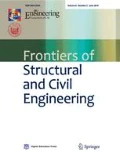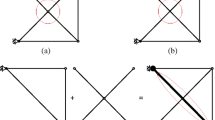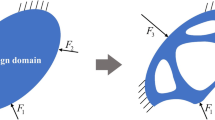Abstract
This paper proposes a sensitivity-based border-search and jump reduction method for optimum design of spatial trusses. It is considered as a two-phase optimization approach, where at the first phase, the first local optimum is found by few analyses, after the whole searching space is limited employing an efficient random strategy, and the second phase involves finding a sequence of local optimum points using the variables sensitivity with respect to corresponding values of constraints violation. To reach the global solution at phase two, a sequence of two sensitivity-based operators of border-search operator and jump operator are introduced until convergence is occurred. Sensitivity analysis is performed using numerical finite difference method. To do structural analysis, a link between open source software of OpenSees and MATLAB was developed. Spatial truss problems were attempted for optimization in order to show the fastness and efficiency of proposed technique. Results were compared with those reported in the literature. It shows that the proposed method is competitive with the other optimization methods with a significant reduction in number of analyses carried.
Similar content being viewed by others
References
Kling R M, Banerjee P. ESP: Placement by simulated evolution. IEEE Transactions on Computer-Aided Design of Integrated Circuits and Systems, 1989, 8(3): 245–256
Goldberg D E, Holland J H. Genetic algorithms and machine learning. Machine Learning, 1988, 3(2–3): 95–99
Battiti R, Tecchiolli G. The reactive Tabu search. ORSA Journal on Computing, 1994, 6(2): 126–140
Dorigo M, Maniezzo V, Colorni A. Ant system: Optimization by a colony of cooperating agents. IEEE Transactions on Systems, Man, and Cybernetics. Part B, Cybernetics, 1996, 26(1): 29–41
Kennedy J. Particle swarm optimization. In: Sammut C, Webb G I, eds. Encyclopedia of Machine Learning. Boston: Springer, 2011, 760–766
Yang X, Deb S. Cuckoo search via levy flight. In: Proceedings of World Congress on Nature and Biologically Inspired Algorithms. IEEE, 2009, 210–214
Eusuff M, Lansey K, Pasha F. Shuffled frog-leaping algorithm: A memetic meta-heuristic for discrete optimization. Engineering Optimization, 2006, 38(2): 129–154
Yang X S, Karamanoglu M, He X. Flower pollination algorithm: A novel approach for multiobjective optimization. Engineering Optimization, 2014, 46(9): 1222–1237
Xing B, Gao W J. Fruit fly optimization algorithm. In: Innovative Computational Intelligence: A Rough Guide to 134 Clever Algorithms. Cham: Springer, 2014, 167–170
Varaee H, Ghasemi M R. Engineering optimization based on ideal gas molecular movement algorithm. Engineering with Computers, 2017, 33(1): 71–93
Park J, Ryu M. Optimal design of truss structures by rescaled simulated annealing. KSME International Journal, 2004, 18(9): 1512–1518
El Dor A, Clerc M, Siarry P. A multi-swarm PSO using charged particles in a partitioned search space for continuous optimization. Computational Optimization and Applications, 2012, 53(1): 271–295
Dhadwal M K, Jung S N, Kim C J. Advanced particle swarm assisted genetic algorithm for constrained optimization problems. Computational Optimization and Applications, 2014, 58(3): 781–806
Hayalioglu M S. Optimum load and resistance factor design of steel space frames using genetic algorithm. Structural and Multidisciplinary Optimization, 2001, 21(4): 292–299
Shahnazari-Shahrezaei P, Tavakkoli-Moghaddam R, Kazemipoor H. Solving a new fuzzy multi-objective model for a multi-skilled manpower scheduling problem by particle swarm optimization and elite Tabu search. International Journal of Advanced Manufacturing Technology, 2013, 64: 1517
Camp C V, Bichon B J, Stovall S P. Design of steel frames using ant colony optimization. Journal of Structural Engineering, 2005, 131 (3): 369–379
Kaveh A, Talatahari S. Optimum design of skeletal structures using imperialist competitive algorithm. Computers & Structures, 2010, 88(21): 1220–1229
Gandomi A H, Yang X S, Alavi A H. Cuckoo search algorithm: A metaheuristic approach to solve structural optimization problems. Engineering with Computers, 2013, 29(1): 17–35
Sheikhi M, Ghoddosian A. A hybrid imperialist competitive ant colony algorithm for optimum geometry design of frame structures. Structural Engineering and Mechanics, 2013, 46(3): 403–416
Dede T, Togan V. A teaching learning based optimization for truss structures with frequency constraints. Structural Engineering and Mechanics, 2015, 53(4): 833–845
Salar M, Ghasemi M R, Dizangian B. A fast GA-based method for solving truss optimization problems. International Journal of Optimization in Civil Engineering, 2015, 6(1): 101–114
Farshchin M, Camp C V, Maniat M. Multi-class teaching-learningbased optimization for truss design with frequency constraints. Engineering Structures, 2016, 106: 355–369
Artar M. A comparative study on optimum design of multi-element truss structures. Steel and Composite Structures, 2016, 22(3): 521–535
Bekdaş G, Nigdeli S M, Yang X S. Sizing optimization of truss structures using flower pollination algorithm. Applied Soft Computing, 2015, 37: 322–331
Kanarachos S, Griffin J, FitzpatrickME. Efficient truss optimization using the contrast-based fruit fly optimization algorithm. Computers & Structures, 2017, 182: 137–148
Ghasemi H, Park H S, Rabczuk T. A level-set based IGA formulation for topology optimization of flexoelectric materials. Computer Methods in Applied Mechanics and Engineering, 2017, 313: 239–258
Hamdia K M, Silani M, Zhuang X, He P, Rabczuk T. Stochastic analysis of the fracture toughness of polymeric nanoparticle composites using polynomial chaos expansions. International Journal of Fracture, 2017, 206(2): 215–227
Vu-Bac N, Lahmer T, Zhuang X, Nguyen-Thoi T, Rabczuk T. A software framework for probabilistic sensitivity analysis for computationally expensive models. Advances in Engineering Software, 2016, 100: 19–31
Dizangian B, Ghasemi M R. Ranked-based sensitivity analysis for size optimization of structures. Journal of Mechanical Design, 2015, 137(12): 121402
Belegundu A D, Chandrupatla T R. Optimization Concepts and Applications in Engineering. Cambridge: Cambridge University Press, 2011
Khan M R, Willmert K D, Thornton W A. A new optimality criterion method for large scale structures. In: Proceedings of 19th Structures, Structural Dynamics and Materials Conference, Structures, Structural Dynamics, and Materials and Co-located Conferences. Bethesda, 1979
Li L J, Huang Z B, Liu F, Wu Q H. A heuristic particle swarm optimizer for optimization of pin connected structures. Computers & Structures, 2007, 85(7–8): 340–349
Lee K S, Geem Z W. A new structural optimization method based on the harmony search algorithm. Computers & Structures, 2004, 82 (9–10): 781–798
Talatahari S, Kheirollahi M, Farahmandpour C, Gandomi A H. A multi-stage particle swarm for optimum design of truss structures. Neural Computing & Applications, 2013, 23(5): 1297–1309
Perez R E, Behdinan K. Particle swarm approach for structural design optimization. Computers & Structures, 2007, 85(19–20): 1579–1588
Degertekin S O. Improved harmony search algorithms for sizing optimization of truss structures. Computers & Structures, 2012, 92–93: 229–241
Kaveh A, Sheikholeslami R, Talatahari S, Keshvari-Ilkhichi M. Chaotic swarming of particles: A new method for size optimization of truss structures. Advances in Engineering Software, 2014, 67: 136–147
Soh C K, Yang J. Fuzzy controlled genetic algorithm search for shape optimization. Journal of Computing in Civil Engineering, 1996, 10(2): 143–150
Kazemzadeh Azad S. Optimum design of structures using an improved firefly algorithm. International Journal of Optimization in Civil Engineering, 2011, 1(2): 327–340
Hadidi A, Azad S K, Azad S K. Structural optimization using artificial bee colony algorithm. In: Proceedings of 2nd International Conference on Engineering Optimization. 2010, 6–9
Author information
Authors and Affiliations
Corresponding author
Rights and permissions
About this article
Cite this article
Dizangian, B., Ghasemi, M.R. Border-search and jump reduction method for size optimization of spatial truss structures. Front. Struct. Civ. Eng. 13, 123–134 (2019). https://doi.org/10.1007/s11709-018-0478-2
Received:
Accepted:
Published:
Issue Date:
DOI: https://doi.org/10.1007/s11709-018-0478-2




